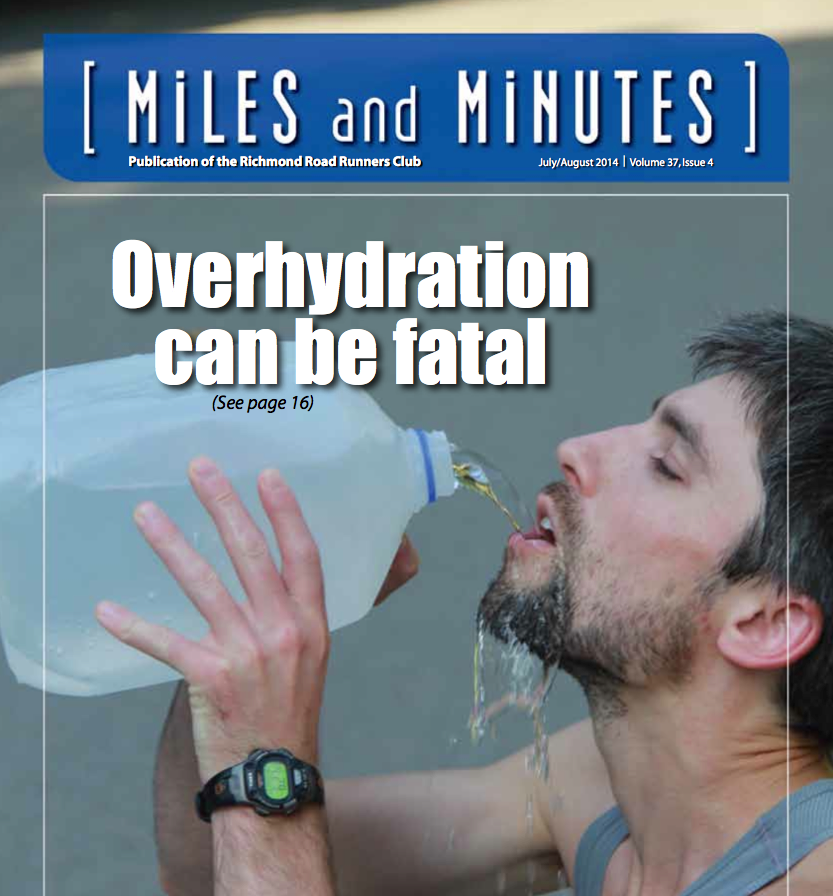Another article my professor and I wrote together. Take a look to see how to make your own sports hydration drink, similar to the popular Gatorade ® or Powerade ®. Now that’s it’s hot and humid again, you need to hydrate properly and appropriately.
To drink or not to drink, that is the question ….
By Paula Inserra and Wesley Smith
You might be thinking the answer to this question is easy, but we’re not talking about a Richmond microbrew at happy hour on Friday night; we mean a tall bottle of water during a long run. We’re sure you’ve heard it said time and time again, “Hydrate, Hydrate, Hydrate!” But did you know that this is a relatively recent recommendation? Up until around the 1950s runners wore cotton, short-shorts, tube socks and were actually told not to drink during a run.
Drinking water during a race was considered a sign of weakness. So, what changed? Research and the subsequent explosion of the sports drink industry.
Research showed that performance significantly decreased when individuals lost more than 2% of body weight during a run. This morphed into a recommendation to drink to prevent dehydration and 0% weight loss; that is, drink in the absence of thirst. You may have heard the newer adage, “If you’re thirsty, you’re already dehydrated.”
So, if you’ll excuse the pun, athletes took this message and ran with it. Water bottles, sports drinks, hydration belts, Camelbacks® and water stops every two miles of a race. The sports drink industry loved the fact that sports scientists were promoting their product! The result? We’ve overdone it.
Today the major running-related health problem known to have potentially deadly consequences is overhydrating. Drinking too much results in Exercise-Associated Hyponatremia (EAH) or low blood levels of sodium.
When we sweat during a run, we lose both water and electrolytes (mainly sodium) but we replace only the water. This is true even if we exclusively drink full-strength sports drinks (which few of us do) because sports drinks are low in sodium.
The American College of Sports Medicine (ACSM) recommends that long-distance runners (marathoners and ultra-marathoners) should consume sodium at a concentration of 0.5-0.7g/liter. Most commercially available sports drinks contain 0.2-0.4g/liter.
Certain factors increase the risk of EAH. They include duration of exercise (4 hours or more of running at a slow pace); being female; having low body weight; excessive drinking (more than 1.5 liters of fluid per hour); pre-exercise overhydration; use of NSAIDS and extreme environmental temperatures.
It has been estimated that 2-10% of marathoners experience EAH. EAH has some physiological basis, mainly a result of the kidneys not excreting excess water during exercise, but most cases are thought to be a result of drinking excessively.
Low sodium in the blood can occur by drinking water or other low sodium beverages at a volume that exceeds sweat rate or by drinking the optimal amount, but not replacing the lost sodium. Both situations result in a dilution of sodium in the blood. Staying optimally hydrated is a balancing act. The goal is to prevent dehydration and excessive sodium loss while avoiding overhydration.
The good news is this is easier to do than it seems. While it is useful to know your sweat rate so you can replace the exact amount of water lost, drinking to thirst comes pretty close (less than 1.0 liter per hour).
Adding a little extra sodium to your favorite sports drink can also help. One-quarter to one-eighth teaspoon of table salt added to a liter of sports drink will bump up the sodium content to meet the ACSM recommendations. Of note is that one of those little packets of salt you might find in restaurants contains about 300mg, which is enough to supplement a liter or a 32-ounce bottle of sports drink.
Sports drinks contain interesting colorings and other additives that won’t help performance. Yellow 5, red 40, blue 1, acesulfame-K, modified food starch, acacia gum, glycerol esters of wood rosins, sucralose and brominated vegetable oil (BVO; an industrial flame retardant!).
Since we generally don’t expect to burst into flames on a run, we’d just as soon avoid ingesting flame retardants. Plus, it’s so easy to mix up a batch of your own sports drink. Try this tasty home-made version to optimize your hydration.
Basic Recipe
1 liter of water
3⁄4 tsp sea salt
1⁄4 cup organic sugar or honey
Pinch of salt substitute
Sample Add-In’s
Minced ginger
Crushed mint leaves
Orange, lemon or lime slices
Sliced cucumber
Paula Inserra, PhD, RD, is an associate professor at Virginia State University, where she heads the Didactic Program in Dietetics. She holds a doctorate in nutrition science from the University of Arizona.
Wesley Smith, BS, is completing a post-baccalaureate certificate program in nutrition and dietetics at VSU.
Here’s a link to the Gdrive it’s hosted on, in case you want to pass it on, and I’ve attached a PDF copy. You can pick up a hard copy at local Richmond, VA running stores like Carytown Running , 3 Sports, or Finish Line for free.

